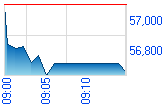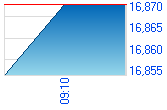Pharma earnings preview Key points
Live Online Trading News, Live Online Stock Prices NSE, BSE, Live Online Stock Recommendations
www.mReach.net ... for Live TV, Radio & FM channelswww.mReach.netFor Live TV, Radio & FM channels |
Live BSE Live NSE 
|
Wednesday, April 9, 2008
Pharma earnings
After months of underperformance, the pharmaceutical sector is finally back in the limelight. The uncertain market conditions have forced investors to take shelter in defensive plays like pharmaceuticals. Further, under-ownership of the sector by foreign investors along with high dividend yield of most of the pharmaceutical stocks has made them an attractive investment opportunity.
We remain positive on the Indian pharmaceutical sector on account of the steady domestic growth, growing revenues from generics in the regulated markets, geographical expansion into growing emerging markets, synergies arising out of integration of acquisitions, and unlocking of value from the demerger and listing of discovery research operations.
The domestic market maintained its growth momentum at 13.6% during the fourth quarter of FY2008. We expect companies like Cipla, Sun Pharmaceuticals (Sun Pharma) and Lupin, which have a high exposure to the domestic market, to benefit from the sustained momentum in the domestic pharmaceutical market and continue to outpace the industry growth.
After continually appreciating for the last three quarters, the rupee has reversed its trend by depreciating 1.3% against the US Dollar during Q4FY2008. This will lead to companies with outstanding foreign exchange (forex) liabilities (including foreign currency convertible bonds [FCCBs]) reporting translation losses. We expect Ranbaxy Laboratories (Ranbaxy) and Orchid Chemicals (Orchid) to report marginal forex losses in their Q4FY2008 results (as compared with strong forex gains recorded in the previous quarters). However, the rupee is yet almost 10% stronger against the US Dollar on a year-on-year (y-o-y) basis, resulting in lower realisation on exports year on year (yoy).
Further, the Indian Rupee has appreciated by around 8.7% against the Pound Sterling over the last one year. Thus, companies like Wockhardt, which have a high exposure to the UK market, will suffer, even though the impact will be partially mitigated by the 3.1% depreciation in the rupee against the euro. Any further movement in the rupee/pound or the rupee/euro exchange rates will affect the performance of companies like Wockhardt (through Pinewood, Negma, CP, Wallis and Esparma), Dr Reddy's Laboratories (DRL; through Betapharm) and Ranbaxy (through Terapia), which have a high exposure to the European market.
The competition in the US generic market continues to remain stiff. While the competitive scenario is unlikely to improve, further deterioration is also unlikely, given that most products are already at a 97-99% discount to the innovator's brand. In view of the tough competitive landscape in the USA, companies with vertically integrated business models, a large product portfolio with complex and niche products, a strong pipeline of Para IV/one-time opportunities and a geographically diversified presence will remain at an advantage.
The risk-appetite of the Indian players has been on the rise. Apart from becoming aggressive participants in the risky Para IV patent challenge space, Indian companies like Sun Pharma have also taken calculated risks by making at-risk launches of Para IV-related products like generic Protonix and generic Ethyol. We expect the combined exclusivities of Protonix and Oxcarbazepine to add substantially to Sun Pharma's revenues and profits during Q4FY2008, while the revenues from the recently launched generic Ethyol under exclusivity will reflect in the Q1FY2009 performance.
Over the past few quarters, Indian pharmaceutical companies have been looking at innovative ways to unlock value of the assets that they have built over the years. While Sun Pharma, Nicholas Piramal, Ranbaxy and Wockhardt have decided to de-merge and subsequently list their drug discovery operations, Glenmark has decided to split its business into specialty and generics segments, along the lines of Novartis and Sandoz. The announcement of the demerger details and listing of the demerged entities in the coming quarters will act as a strong trigger for these stocks.
Companies under our coverage are expected to report a 25.0% growth in profits on the back of a 23.8% increase in the revenues for Q4FY2008. The top line of the companies under our coverage would be driven by the new product launches in the regulated markets, strong growth in the contract research and manufacturing services (CRAMS) businesses of these companies and consolidation of the acquisitions made in the previous year.
The operating profit margin (OPM) of companies under our coverage is expected to expand by 360 basis points, largely driven by one-time exclusivity revenues (Sun Pharma), savings arising out of the de-merger of research and development (R&D) units (Ranbaxy, Nicholas Piramal) and the low base of Q4FY2007 (Ranbaxy and Ipca Laboratories). The sharp expansion in the margins will be mitigated by the relatively lower other income, due to forex losses (Ranbaxy & Orchid) and higher interest and depreciation costs (due to acquisitions in the case of Wockhardt, Lupin and Cadila Healthcare).
The key risk to our estimates for Q4FY2008 is the disclosure of any forex losses in the derivative segment reported by companies. However, most leading companies like Ranbaxy and Wockhardt have denied having recorded any such losses.
Front-line companies such as Ranbaxy and Cipla would show good growth in revenues and earnings whereas DRL would post a decline in both the top line and the bottom line due to the high base of Q4FY2007 (during which the company had recorded one-time revenues from the Ondansetron exclusivity). Further, the minor translation losses recorded by Ranbaxy (as compared with the translation gains recorded in the previous quarters) due to the depreciation of the Indian Rupee against the US Dollar would restrict the profit growth posted by the company.
We have not provided quarterly estimates for Aurobindo Pharma (Aurobindo) in the report below as the company reports stand-alone quarterly numbers while our projections and valuations are based on the consolidated numbers reported by the company. Further, from hereon, we are discontinuing our coverage on Unichem Laboratories in view of the lack of visibility on the export front as the company has been trying to re-negotiate its export contracts after the sharp appreciation in the Indian Rupee against the US Dollar, on account of which export realisations had been sharply hit.
Labels:
SECTOR UPDATE
Please note: Some of the content in this site is from Share khan emails sent to its customers.